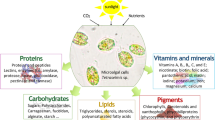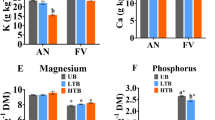Abstract
The extensive grazing systems across northern Australia support approximately 50 % of the national beef herd. Livestock productivity is affected by seasonal variation in pasture quality and quantity. Intensifying livestock production in the north is a challenge, but has been recognised as priority for the Australian economy. Macroalgae offer a sustainable and novel dietary supplement for cattle due to its high nutrient value and biomass production, which are generally superior to forages used in ruminant production systems. This paper highlights some of the existing literature associated with the use of macroalgae for beef cattle and discusses the potential of green freshwater (Cladophora vagabunda, Oedogonium sp., Spirogyra sp.) and marine macroalgae (Cladophora coelothrix, Derbesia tenuissima, Ulva ohnoi) as feed supplements in northern Australian livestock production systems. Crude protein content of the six species of green macroalgae discussed here ranged from 75.4 to 339.1 g kg−1 dry weight (DW). Dietary mineral limitations in northern livestock production systems include phosphorous (P), sulfur (S) and nitrogen. Four of the six macroalgae species had high P content, ranging from 1.4 to 5 g kg−1 DW. Sulfur varied between species, ranging from 2.9 to 57.5 g kg−1 DW, with marine macroalgae having a higher sulfur concentration than freshwater macroalgae. This review demonstrates that green macroalgae have considerable potential to supply a high-protein, high-phosphorous feed supplement for northern livestock production systems dependent on extensive unimproved pastures.
Similar content being viewed by others
References
Angell AR, Mata L, de Nys R, Paul NA (2014) Variation in amino acid content and its relationship to nitrogen content and growth rate in Ulva ohnoi (Chlorophyta). J Phycol 50:216–226
Arieli A, Sklan D, Kissil G (1993) A note on the nutritive value of Ulva lactuca for ruminants. J Anim Sci 57:329–331
Ash A, Smith MS (2003) Pastoralism in tropical rangelands: seizing the opportunity to change. Range J 25:113–127
Braden KW, Blanton JR, Montgomery JL, van Santen E, Allen VG, Miller MF (2007) Tasco supplementation: effects on carcass characteristics, sensory attributes, and retail display shelf-life. J Anim Sci 85:754–768
Callaghan M, Tomkins N, Benu I, Parker A (2014) How feasible is it to replace urea with nitrates to mitigate greenhouse gas emissions from extensively managed beef cattle? J Anim Sci 54:1300–1304
Cole AJ, de Nys R, Paul NA (2014) Removing constraints on the biomass production of freshwater macroalgae by manipulating water exchange to manage nutrient flux. PLoS One 9(7):e101284
de Paula Silva PH, de Nys R, Paul NA (2012) Seasonal growth dynamics and resilience of the green tide alga Cladophora coelothrix in high-nutrient tropical aquaculture. Aqua Environ Inter 2:253–266
Dixon R, Coates D (2010) Diet quality estimated with faecal near infrared reflectance spectroscopy and responses to N supplementation by cattle grazing buffel grass pastures. Anim Feed Sci Tech 158:115–125
Evans FD, Critchley AT (2014) Seaweeds for animal production use. J Appl Phycol 26:891–899
FAO (2014) Food and Agricultural Organization of United Nations: Economic and social department: The statistical division. http://faostat.fao.org/site/567/DesktopDefault.aspx?PageID=567#ancor. Updated 7 February 2014; verified 4 March 2014
Galland-Irmouli AV, Fleurence J, Lamghari R, Lucon M, Rouxel C, Barbaroux O, Bronowicki JP, VillaumeC GJL (1999) Nutritional value of proteins from edible seaweed Palmaria palmata (dulse). J Nutr Biochem 10:353–359
Hamlyn-Hill F (2012) Mineral and vitamins [Online]. In: Future beef. Available at http://futurebeef.com.au/topics/nutrition/minerals-and-vitamins/. Posted 8 May 2012; verified 4 March 2014
Holdt SL, Kraan S (2011) Bioactive compounds in seaweed: functional food applications and legislation. J Appl Phycol 23:543–597
Hunt LP (2008) Safe pasture utilisation rates as a grazing management tool in extensively grazed tropical savannas of northern Australia. Range J 30:305–315
Hunt L, Ash A, MacLeod N, McDonald C, Scanlan J, Bell L, Cowley R, Watson I, McIvor J (2014) Research opportunities for sustainable productivity improvement in the northern beef industry: a scoping study. Final report. Meat & Livestock Australia Ltd, Sydney
Jackson D, Rolfe J, English B, Holmes B, Matthews R, Dixon R, Smith P, MacDonald N (2012) In: Partridge I (ed) Phosphorus management of beef cattle in northern Australia. Meat & Livestock Australia Ltd, Sydney
Kennedy P, Charmley E (2012) Methane yields from Brahman cattle fed tropical grasses and legumes. Anim Prod Sci 52:225–239
Leupp JL, Caton JS, Soto-Navarro SA, Lardy GP (2005) Effects of cooked molasses blocks and fermentation extract or brown seaweed meal inclusion on intake, digestion, and microbial efficiency in steers fed low-quality hay. J Anim Sci 83:2938–2945
Lyman CM, Kuiken K, Hale F (1956) Amino acids in feedstuffs, essential amino acid content of farm feeds. J Agric Food Chem 4:1008–1013
Machado L, Magnusson M, Paul NA, de Nys R, Tomkins N (2014) Effects of marine and freshwater macroalgae on in vitro total gas and methane production. PloS One 9:e85289
Magnusson M, Mata L, de Nys R, Paul NA (2014) Biomass, lipid and fatty acid production in large-scale cultures of the marine macroalga Derbesia tenuissima (Chlorophyta). Mar Biotechnol 16:456–464
McDonald P, Edwards R, Greenhalgh J, Morgan C, Sinclair L, Wilkinson R (2011) Evaluation of foods: protein. In ‘Animal Nutrition’. Pearson Education Ltd, Essex, pp 303–339
McRae T, Thomas B (2014) Australian cattle industry projections. Mid-year update. Meat & Livestock Australia Ltd, Sydney
Neveux N, Magnusson M, Maschmeyer T, de Nys R, Paul NA (2014a) Comparing the potential production and value of high-energy liquid fuels and protein from marine and freshwater macroalgae. GCB Bioenergy. doi:10.1111/gcbb.12171
Neveux N, Yuen A, Jazrawi C, He Y, Magnusson M, Haynes B, Masters A, Montoya A, Paul N, Maschmeyer T, de Nys R (2014b) Pre- and post-harvest treatment of macroalgae to improve the quality of feedstock for hydrothermal liquefaction. Algal Res 6:22–31
NRC (1996) National research council. Nutrient requirements of beef cattle. National Academy Press, Washington
O’Sullivan L, Murphy B, McLoughlin P, Duggan P, Lawlor PG, Hughes H, Gardiner GE (2010) Prebiotics from marine macroalgae for human and animal health applications. Mar Drugs 8:2038–2064
Paul NA, Tseng C (2012) Seaweed. In: Lucas JS, Southgate PC (eds) Aquaculture: farming aquatic animals and plants. Blackwell Publishing Ltd, Oxford, pp 268–284
Poppi DP, McLennan SR (1995) Protein and energy-utilization by ruminants at pasture. J Anim Sci 73:278–290
Ternouth J (1990) Phosphorus and beef production in northern Australia. 3. Phosphorus in cattle—a review. Trop Grassl 24:159–169
Tothill J, Gillies C (1992) The pasture lands of northern Australia: their condition, productivity and sustainability. Occasional Publication No. 5 Tropical Grassland Society of Australia, Brisbane
Acknowledgments
This research is part of the MBD Energy Research and Development program for Biological Carbon Capture and Storage. This work was co-funded by the National Livestock Methane Program, through funding from the Australian Government Department of Agriculture, Carbon Farming Futures Filling the Research Gap Program and Meat and Livestock Australia; the Australian Renewable Energy Agency, and the Advanced Manufacturing Cooperative Research Centre.
Author information
Authors and Affiliations
Corresponding author
Rights and permissions
About this article
Cite this article
Machado, L., Kinley, R.D., Magnusson, M. et al. The potential of macroalgae for beef production systems in Northern Australia. J Appl Phycol 27, 2001–2005 (2015). https://doi.org/10.1007/s10811-014-0439-7
Received:
Revised:
Accepted:
Published:
Issue Date:
DOI: https://doi.org/10.1007/s10811-014-0439-7




